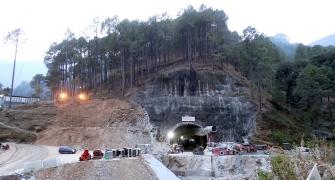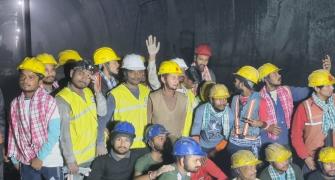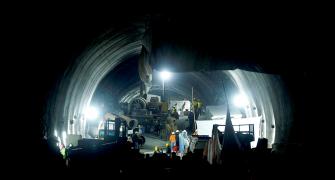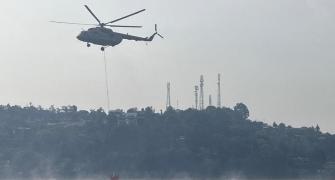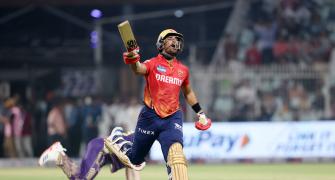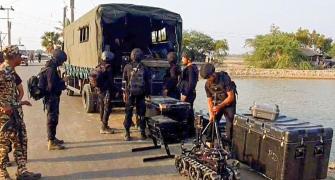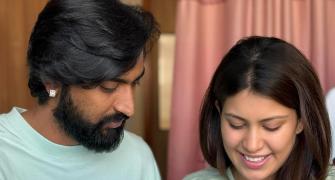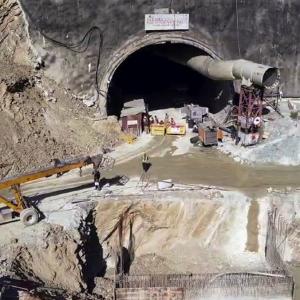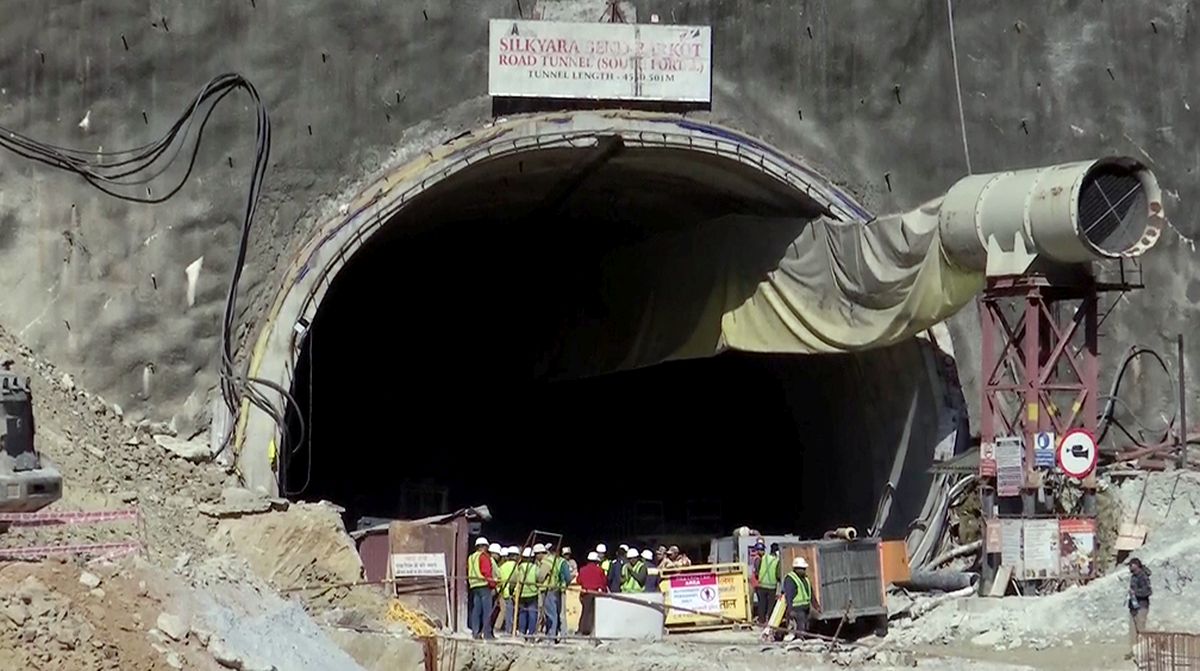'I've never seen such cooperation before. Problem solving. Everyone working together. And truthful.'
'Someone from the prime minister's office was there the entire time, at the table, one of the team.'

Aussie tunnel rescue hero Professor Arnold Dix spent 18 adrenaline-rush days in India.
Dix, who flies around the world -- "a global trouble shooter and fixer, practical and legal, usually trying to understand what went wrong, so we don't do it again or solving a problem, do something new, fixing something, mostly, but not always, helping governments from contracts to construction and, of course, disasters" -- felt each of the days he spent in India were marvellous learning experiences, both culturally and professionally.
He had a chance to interact with people from such unbelievably diverse backgrounds.
He loaded up on a dozen types of spiritual experiences, that warmed his soul.
He got to know a little bit about the Himalayas in all their stupendous glory.
He had the very enjoyable opportunity, post the rescue, of spending a few days attending a wedding in New Delhi, between a reception in his honour at the Australian high commission and meetings at the ministry of road transport and highways.
"I've never been to an Indian wedding. I just enjoyed being part of an Indian family, with the kids and eating food with them. I really liked being inside an Indian family and how it was quite gentle and calm."
Dix had too the impressive experience of a typical Indian working environment, where umpteen dozen voices and opinions get heard, but yet the job gets done, often perfectly.
"I've never seen such cooperation before. Problem solving. Everyone working together. And truthful. Someone from the prime minister's office was there the entire time, at the table, one of the team."
In the second part of his interview to Rediff.com's Vaihayasi Pande Daniel, the exuberant Dix, who communicates on WhatsApp with a whole load of emojis, especially preferring hearts and namastes, at all odd hours of his night, recalls some of those exciting days.
- Part 1 of the Interview: 'We're going to bring these kids home'
From the outside, it looked chaotic. We're used to sort of chaotic situations in India, every day is chaotic.
But was it really that chaotic at Ground Zero?
No, I'm not saying it didn't look chaotic. And I think that's one of the things I learned about India that I didn't fully appreciate. There's a way that things are done in India that look chaotic. But it's not actually chaotic at all.
It's sort of like a dance. It has its own rhythm. So, it's something much more subtle.
And it took me probably a day or two to tune into it.
For example, in a meeting where we had, say, 20 absolutely awesome experts sitting around, I'm just one voice. As best I could tell, all 20 of them -- well, 19 of them because I wasn't doing it, because I hadn't figured out how to -- but say 19 of the 20 are all talking simultaneously.
I'm trying to figure out what this all means. Then it suddenly dawns on me that we are really, really rapidly exchanging ideas between everybody who was in the room, through multiple concurrent conversations. And then all of a sudden, wisdom pops out at the end.
We have quite a focused discussion and we come to a decision. I learned that it's not actually chaos. It's a form of a particular type of quite intellectual and quite constructive sort of negotiated truth-seeking, albeit particularly Indian style.
I became a bit of a fan, because it meant that all the voices would be heard, and everybody was satisfied that they had been heard. But in the end, also, we could make a strategic decision. I think I learned a bit of a trick. Hadn't ever been involved in that before. And I've thought I was a bit privileged to be inside it and to actually witness the results of it.
So yes, it might look a bit chaotic, say at Ground Zero, but everyone knew what they were doing. There were a few spectators and everything, but actually there was a method to the madness. In the end it achieved a result which is almost unimaginable. We got the perfect result! So however, we did it, that was the correct way, because we got the result.

At no point did you sort of feel these people didn't know what they were doing?
No, no, I didn't feel that at all. Felt quite the contrary. I thought they knew exactly what they were doing. I thought I was just being brought into the mix, because there were some issues that were being faced, where the mountain wasn't behaving as expected. And I'd agreed with them.
When the first calls came to me, basically just bouncing ideas off me in those first few days, I thought the strategy that was being described was fine. And I'd said that.
But what the mountain was doing was proving us wrong, and teaching us a few lessons about what techniques would be appropriate and how we could make progress and how we wouldn't make progress. I think that's why I was brought in, because the mountain wasn't quite behaving how we expected and therefore 'Well, what other brains can we bring in? And what other experience can we bring to the table', and I was part of that.
I just came into almost like a problem-solving class. 'Okay, so things aren't going so well, let's put some other ingredient into this mix, and see what we come up with'. I was another ingredient in a really sophisticated, decision management problem-solving group.

It seems apparent from speaking to you that the Mountain itself was one more character in the mix?
The news coverage did not really convey that?
The Mountain was always a character for me.
In my discussions (to the outside world) I would say: 'The mountain is teaching us things'. Someone would say to me: 'You have failed'. I would say 'No, we have not failed. The mountain taught us a new lesson'.
Very much my narrative, the way I understood what was going on and the conceptual model that I was using was a mountain had chosen to basically take hostage 41 people. But it also had chosen not to hurt them. It had also chosen to leave intact, a pipe that we could use to give them food, medicine and water. And it also chose to let us put a bigger one in to give them some hot food and get video footage as well.
It was a very, very, interesting scenario. Normally when I get called in, it's a tragedy already. This wasn't a tragedy. This was a rescue mission.
It was almost like a puzzle (presented by the mountain): 'So here you go. I've got 41 of your kids, and they're inside. And they're warm, they're fed, and I've got medicine and water. Now you have to figure out how to get them out. And I'm just gonna sit here patiently. But if you annoy me, I could actually ruin the whole game for you and for the people in here, which is the avalanche'.
That was how I was looking at it. How do we how do we do a deal with this Mountain? How do we persuade this Mountain that it's okay to let these 41 young men out? Certainly that's the way I was talking and thinking about it. Because that's what made this different. That's what made this unlike any mine rescue I've ever done before.
There was, of course, that spiritual dimension as well, where the local people believed that the reason that the collapse that occurred was because the shrine where you do your prayers, just near the portal, that had been knocked out. There was a real sort of metaphysical spiritual element to it, which I thought was very real. Very real, because you're in the land of the gods. And this road is to link the most holy of places for the Hindu people.
All these things are to be taken seriously. I've never dealt with anything quite like this before, that's for sure.

Jugaad is a commonly used word in India -- maybe you have heard of it after this experience in India?
Jugaad is in some sort of unbelievable chaotic way to find an unexpected, makeshift, resourceful, not-so-sophisticated, but very workable solution to a tricky problem.
All of you experts were there, with these auger machines and other giant machines. Finally, the 41 were taken out by these men who are unfortunately named rat miners.
That was a very sort of illustrative example of the way India pulls off things. What do you have to say about the way this jugaad solution ultimately emerged?
The solution that popped up -- you're right unfortunately they are called rat miners -- is the traditional way that we deal with something like this. We go back to ancient forms of excavation, which are inherently safe -- that is small-dimension mining by hand. And small-dimension mining by hand is what we did and what I was supporting.
It's not exactly a sexy solution like a big machine making a big noise and all the rest of it. It's an elegant solution. It's a gentle solution. It's a harmonious solution.
It took blowing the auger up, busting all its bearings, ripping itself out of the ground, busting its clutch and tearing its auger bits apart, for everyone just sort of slap themselves in the face and go, 'Oh, yeah, maybe softly, softly would be a good idea', which is, of course, what we did in the end. And softly, softly won the day.

Who were some of the interesting people that you met and maybe had an effect on you?
One of the things that I discovered is, there's almost no boundary to the interesting sort of characters you bump into in India. It's completely accepting, no matter what your particular style or personality is.
Everyone even politicians who, on the media gave one impression, but in public were just really kind and personable (or maybe I just didn't understand the media).
I was really struck by the characters within the Uttarakhand government, how incredibly focused on problem solving and intellectually robust they were.
I liked the stoic rescue teams, who were actually just the most lovely men, who I spent the day dancing and singing up a mountain with. You might've seen the video of us dancing and singing on a log. I don't know quite how that happened. Just the most lovely men!
There was a spiritual leader for the local god, who looked at me with eyes that I've never been looked at before. I can -- like while I'm talking to you -- still see his eyes and they kind of looked right into me.
And I remember after the rescue, his head got sort of pushed up against the car. I was being whisked away in some car, because of fear that I'd be mobbed or whatever. I caught his eyes and his eyes caught mine.
And I'm like, 'I'm going to see him again, I'm going to see him again'. And that was that was communicated to me in this really weird way. Like, 'I'm going to see you again' and I was like, 'Yeah, I'm gonna see you again. I don't know when, but I'm gonna see you'.
And there was the gentleman, I forget his name, but he inhabits the top of the hill and he looks a bit like he might have been there when the Beatles first turned up. Like an old bloke in a smoky room. There was something about him, a really fascinating sort of character. He came out, greeted me and gave me a blessing.
Or the guys that I set up with at the portal, who had the beads, the 41 beads that they placed before that we actually executed the evacuation.
Or the engineer to whom I said, 'I need your help. I want to get a yellow hat blessed' because the yellow hats were the hats that the men on the other side wore and the also the men who were doing the main rescue. He came up with the plan of doing the hat exchange with the head of the auger team.
He was sort of like my spiritual adviser. When we turned up in the tunnel, the very person we were looking for (the head of the guys who were doing the auger disassembly) was right there. We did the hat exchange. Magically, the next minute, the guys who do the blessings were there. The next moment the hats had been blessed.
They were all like characters out of this extraordinarily outrageous, totally non-believable movie or something. It was just wonderful.
WATCH: Australian Prime Minister Anthony Albanese praises Arnold Dix
- Part 3 of the Interview: 'My mum was worried I was going to be killed'
Feature Presentation: Aslam Hunani/Rediff.com

